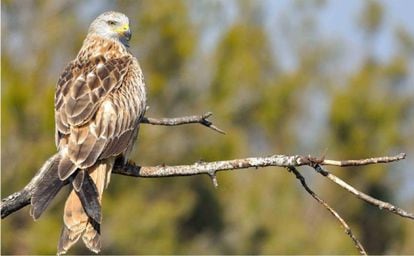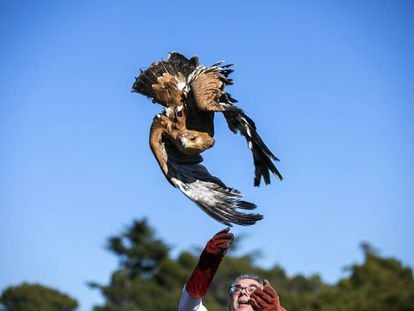Red kite: a bird of prey on the brink of extinction in southern Spain
Experts say the species could disappear from the region within 20 years if urgent measures are not taken


The red kite (Milvus milvus) will disappear completely from the south of Spain if nothing is done to stop its falling numbers. Forty years ago, 70 pairs of red kites lived in the mountain ranges of Sierra Morena, Cazorla and Odiel, but today that number has dropped to just three.
Doñana National Park provides a refuge for 28 pairs, but even in this protected reserve, there are signs of decline. Julio Blas and Fabrizio Sergio, researchers at the Doñana Biological Station, warn that if urgent measures are not introduced, the bird, whose population has fallen by 95%, will be extinct within 20 years.
Forty years ago, an average of 100 red kites were born every year in the reserve. Today the average is 10
“If it wasn’t for Doñana, it would already be extinct,” says Blas, the co-author of a study on the red kite’s dramatic population decline published in Endangered Species Research. Using information taken from field work over nearly half a century, the study found that 40 years ago, an average of 100 red kites were born every year in the reserve. Today the average is 10.
“Doñana is important but it’s not enough. It is not completely closed off, especially for a species with so much mobility,” warns Blas. According to the researcher, the main threats facing the bird are the illegal use of poisons, habitat changes, a decline in prey, exposure to pollution, and an increase in competition with other species.
But none of these reasons alone explains the “historic decline” of the red kite. “Over six decades we have documented a silent and gradual fall in the number of the species, a notable reduction in their distribution area and a deterioration of their reproductive capacity. These phenomena on a regional level are replicated within the Doñana Nation Park, only that here, because it is a protected area, they occur at a much slower rate, and give the false impression that everything is in order in protected areas,” says Sergio, who co-authored the study on the population decline of the red kite.
Sergio and Blas are demanding immediate measures to identify, locate and address the threats. “The priority is understanding the role these factors have on the population decline. It’s likely that these problems are interacting with climate change. We have begun a study on the hormonal system of the species and its relationship to their response capacity to certain ecological aspects,” explains Blas.
Monitoring plan
To address the problem, researchers want the birds to be tagged with GPS tracking devices that can be accessed by remote surveillance teams. These devices would allow researchers to see in real time where the birds are dying, analyze the cause of death and take action to limit the problem. “If we can increase the adult survival rate to the top values recorded in the bibliography, within 10 years we could pass the threshold of 70 pairs that existed in the 1980s,” says Blas.
If it wasn’t for Doñana, it would already be extinct
Researcher Julio Blas
While an agreement on a monitoring plan in the Doñana National Park is set to be signed, Blas says action must be taken immediately. He explains that the red kite faces numerous problems: besides the drop in rabbit numbers – one of the main sources of food of the red kite – there is the increasing frequency of droughts, and the increase in farmland and scrubland, which affect the bird’s hunting areas.
These are issues that affect all birds of prey, although some species have managed to fare better than the red kite. For example, there are 600 pairs of black kites and 300 booted eagles.
The diminishing red kite population is not just a local problem. Species from the north of Europe (particularly France and Germany) which fly down to southern Spain face the same dangers as the Spanish population. With so much at stake, “we have a responsibility” says Blas, to take action to save the red kite in southern Spain.
English version by Melissa Kitson.












































